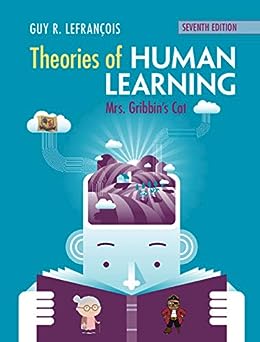Description
Theories of Human Learning: Mrs Gribbin’s Cat 7th Edition, ISBN-13: 978-1108484633
[PDF eBook eTextbook]
- Publisher: Cambridge University Press; 7th edition (December 12, 2019)
- Language: English
- ISBN-10: 1108484638
- ISBN-13: 978-1108484633
Mrs Gribbin invites you to join her as she explores the changing landscape of learning theories and their implications.
Both a serious academic text and an intriguing story, this seventh edition reflects a significant update in research, theory, and applications in all areas. It presents a comprehensive view of the historical development of learning theories from behaviorist through to cognitive models. The chapters also cover memory, motivation, social learning, machine learning, and artificial intelligence. The author’s highly entertaining style clarifies concepts, emphasizes practical applications, and presents a thought-provoking, narrator-based commentary. The stage is given to Mrs Gribbin and her swashbuckling cat, who both lighten things up and supply much-needed detail. These two help to explore the importance of technology for simulating human cognitive processes and engage with current models of memory. They investigate developments in, and applications of, brain-based research and plunge into models in motivation theory, to name but a few of the adventures they embark upon in this textbook.
Table of Contents:
Half-title
Title page
Copyright information
Dedication
Brief Contents
Contents
List of Illustrations
List of Boxes
Preface: Read this First. . .
What’s New in the Seventh Edition?
Acknowledgments
Part I Science and Theory
1 Human Learning
What Mrs. Gribbin Said: This Book
Objectives
The Psychology of Learning
Knowing and Consciousness
Defining Learning
Disposition
Capability
Performance
The Definition
Scientific Theories
Theories, Principles, Laws, and Beliefs
Common Misconceptions and Folk Beliefs
Misconceptions About Learning and the Brain
Purposes of Theories
Characteristics of Good Theories
Science and Psychological Theories
What Is Science?
Steps in the Scientific Method
1. Ask the Question
2. Develop a Hypothesis
3. Collect Relevant Observations
4. Test the Hypothesis
5. Reach and Share a Conclusion
Experiments
Sampling and Comparison Groups
Evaluating Psychological Research
Have I Committed the Nominal Fallacy?
Is the Sample Representative?
Can Subjects Be Believed?
Is There a Possibility of Subject Bias?
Is There a Possibility of Experimenter Bias?
Participants in Psychological Research
Ethics in Animal Research
Humans as Research Participants
Theories of Learning: A Brief Overview
Structuralism and Functionalism
Classification of Learning Theories
Preview of this Text
Chapter 2. Early Behaviorism: Pavlov, Watson, and Guthrie
Chapter 3. The Effects of Behavior: Thorndike and Hull
Chapter 4. Operant Conditioning: Skinner’s Radical Behaviorism
Chapter 5. Evolutionary Psychology: Learning, Biology, and the Brain
Chapter 6. Transition to Modern Cognitivism: Hebb, Tolman, and the Gestaltists
Chapter 7. Cognitive Theories: Bruner, Piaget, and Vygotsky
Chapter 8. Learning and Memory
Chapter 9. Motivation and Emotions
Chapter 10. Social Learning: Bandura’s Social Cognitive Theory
Chapter 11. Machine Learning and Artificial Intelligence: The Future?
Chapter 12. Analysis, Synthesis, and Integration
Applications of Learning Theories
Main Point Chapter Summary
Part II Mostly Behavioristic Theories
2 Early Behaviorism: Pavlov, Watson, and Guthrie
This Chapter
Objectives
Early Scientific Psychology
Psychophysics
Absolute Threshold
Differential Threshold
Ivan P. Pavlov (1849–1936)
Classical (Pavlovian) Conditioning
Human Reflexes
Behavioristic Explanations for Learning: Contiguity and Reinforcement
Contingency and Contiguity
Biological Predispositions and Backward Conditioning
Findings in Classical Conditioning
Acquisition
Extinction and Recovery
Generalization and Discrimination
Higher-Order Conditioning
Educational Implications of Pavlovian Conditioning
An Appraisal of Pavlov’s Classical Conditioning
John B. Watson (1878–1958)
Behaviorism
Watson’s Explanation of Learning
Conditioned Emotional Reactions
Little Albert
Transfer
Positive Emotions
The Controversy
Transfer in Everyday Life
Watson’s Environmentalism
Higher Learning
Practical Applications of Watson’s Behaviorism
Attitudes and Emotions
Behavior Modification
An Appraisal of Watson’s Behaviorism
Edwin R. Guthrie (1886–1959)
Guthrie’s Law of One-Shot Learning
What the Law Means
One-Shot Learning
The Role of Repetition
One-Shot Classical Conditioning
Movement-Produced Stimuli
Contiguity through MPS
Habits
Extinction
Reward and Punishment
Practical Applications of Guthrie’s Theory
The Fatigue Technique
The Threshold Technique
The Method of Incompatible Stimuli
Horse Illustrations
Human Illustrations
Cousin Renault
An Appraisal of Guthrie’s One-Shot Learning
Evaluation of Early Behavioristic Theories
Main Point Chapter Summary
3 The Effects of Behavior: Thorndike and Hull
This Chapter
Objectives
Edward L. Thorndike’s Connectionism
Animal Intelligence
Reinforcement and Contiguity: Two Explanations
Thorndike’s Early Theory: Main Laws
The Law of Exercise
The Law of Effect
The Law of Readiness
Subsidiary Laws
1. The Law of Multiple Responses
2. Set or Attitude
3. The Law of Prepotency of Elements
4. Response by Analogy
5. Associative Shifting
Thorndike’s Later Theory: Repealed Laws and New Emphases
Repeal of the Law of Exercise
Half a Law of Effect
Learning by Ideas
An Appraisal of Thorndike’s Connectionism
Clark L. Hull’s Hypothetico-Deductive System
Overview of Hull’s System
Main Components of Hull’s System
Graphic Summary of Hull’s System
Input Variables: Stimuli
Intervening Variables: Connectors
1. SHR
2. D
3. V
4. K
5. SER
Output Variables: Responses
Hull’s Summary Equation Illustrated
Fractional Antedating Goal Reactions
Foresight and Expectancy
Habit-Family Hierarchies
Summary and Appraisal of Hull’s System
Educational Implications of Thorndike and Hull
Main Point Chapter Summary
4 Operant Conditioning: Skinner’s Radical Behaviorism
This Chapter
Objectives
Radical Behaviorism: An Antitheory?
An Overview of Radical Behaviorism
Basic Assumptions
The Experimental Analysis of Behavior
Operant and Respondent Learning
Prevalence of Operant Behavior
The Influence of Charles Darwin and Edward Thorndike
Pavlov’s Harness and Skinner’s Box
Operant Learning
Reinforcement and Punishment
Positive and Negative Reinforcement
Punishment
Punishment versus Negative Reinforcement
Illustrations of Reinforcement and Punishment
Positive Reinforcement (Reward)
Negative Reinforcement (Relief)
Presentation Punishment (Castigation)
Removal Punishment (Penalty)
Primary and Secondary Reinforcers
Schedules of Reinforcement
Continuous or Intermittent Reinforcement
Interval or Ratio Schedules
Fixed or Random Schedules
Superstitious Schedules
Effects of Different Reinforcement Schedules
Magazine Training
Effects of Schedules on Response Acquisition
Effects of Schedules on Extinction
Spontaneous Recovery
Extinction and Forgetting
Effects of Schedules on Rate of Responding
Concurrent Schedules of Reinforcement
Schedules of Reinforcement in Everyday Life
Illustration 1
Illustration 2
Shaping
Chaining
Chains in Shaping
Shaping and Verbal Instructions in Human Learning
Fading, Generalization, and Discrimination
Relevance to Human Learning
Generalization
Discrimination
Individual Differences
Practical Applications of Operant Conditioning
Applications of Positive Contingencies
The Premack Principle
Applications of Aversive Contingencies
The Case Against Punishment
Less Objectionable Forms of Punishment
The Case for Punishment
Negative Reinforcement
Other Applications: Behavior Management
Positive Reinforcement and Punishment
Counterconditioning
Extinction
Skinner’s Position: An Appraisal
Contributions and Applications of Skinner’s Theory
Evaluation as a Theory
Some Philosophical Objections
Main Point Chapter Summary
5 Evolutionary Psychology: Learning, Biology, and the Brain
This Chapter
Objectives
Taste Aversion Learning
Conditioning Explanations for Taste Aversions
Problems with Classical Conditioning Explanations of Taste Aversions
One-Trial Acquisition of Taste Aversions
Delayed Conditioning of Taste Aversions
Selectivity in Taste Aversion Learning
Latent Inhibition and Taste Aversion Learning
Blocking
The Rescorla-Wagner Explanation
A Biological Explanation
Higher-Order Conditioning and Biological Adaptation
Darwin’s Natural Selection and Psychology
Evolutionary Psychology
Autoshaping
Instinctive Drift
Biological Constraints
Evolution of the Brain
Evolutionary Psychology and Learning
Some Reactions to Evolutionary Psychology
Sociobiology: A Precursor of Evolutionary Psychology
Inclusive Fitness and Altruism
Some Reactions to Sociobiology
Evolutionary Psychology: An Appraisal
A Transition
Learning and the Brain
Studying Brain Functions
Brain Injuries
Brain Ablations
Electrical Brain Stimulation
Chemical Brain Stimulation and Addiction
Brain Imaging Techniques
Hindbrain
Midbrain
Forebrain
The Hypothalamus
The Thalamus
The Limbic System
The Cerebrum and the Cerebral Cortex
The Hemispheres
Sex Differences in the Brain
The Brain and Experience
Brain-Based Education
Biofeedback and Neurofeedback
Conditioning of Autonomic Responses: Early Research
How Biofeedback Works
Recent Biofeedback Applications
Main Point Chapter Summary
Part III The Beginnings of Modern Cognitivism
6 Transition to Modern Cognitivism: Hebb, Tolman, and the Gestaltists
This Chapter
Objectives
Hebb’s Theory
Higher Mental Processes
The Physiology of Learning
The Central Nervous System
Neural Transmission
Dopamine
Norepinephrine
Acetylcholine
Serotonin
Hebb’s Main Assumptions
An Illustration of Hebb’s Theory of Perception
Neurological Basis for Learning
The Aplysia: Habituation and Sensitization
Reactivity and Plasticity
Mediating Processes
The Hebb Rule
Co-activation of Cell Assemblies
Learning: The Forming of Associations
Thinking and Learning in Hebb’s Theory
Set and Attention
Educational Applications of Hebb’s Theory
Appraisal of Hebb’s Theory
From Behaviorism to Cognitivism
Mechanistic Behaviorism
Tolman’s Purposive Behaviorism
Do Rats have Purpose?
The Blocked-Path Study
An Expectations Study
A Place Learning Study
A Latent Learning Experiment
What Is Purposive Behaviorism?
Educational Implications and Summary Principles of Tolman’s System
Behavior Is Purposive
Behavior Is Cognitive
Reinforcement Establishes and Confirms Expectancies
A Theory of Purposive Behaviorism Is Molar, Not Reductionist
Appraisal of Tolman’s Purposive Behaviorism
Gestalt Psychology
Insight or Trial and Error
Gestalt Means ”Whole”
Principles of Perception
Prägnanz: Good Form
Principle of Closure
Principle of Continuity
Principle of Similarity
Principle of Proximity
Gestalt Views of Learning and Memory
Leveling
Sharpening
Normalizing
Beyond Perception: The Behavioral Field
The Lake of Constance
The Behavioral Field
Appearance versus Reality
Gestalt Psychology and Modern Cognitivism
Educational Implications of Gestalt Psychology
Appraisal of Gestalt Psychology
Metaphors in Psychology
Metaphors in Behaviorism
Metaphors in Cognitivism
Main Point Chapter Summary
Part IV Mostly Cognitive Theories
7 Three Cognitive Theories: Bruner, Piaget, and Vygotsky
This Chapter
Objectives
Cognitive Psychology
Cognitivism Compared with Behaviorism
The Main Metaphor in Cognitive Psychology
Principal Beliefs of Cognitive Theories
1. Current Learning Builds on Previous Learning
2. Learning Involves Information Processing
3. Meaning Depends on Relationships among Concepts
Bruner’s Theory: Going Beyond the Information Given
Evolution of the Brain
Advantages of Brains
Evolution of Mind
Representation in Children
Symbolic Representation and Cognitive Theory
Bruner’s Theory of Representation: Categorization
What Is a Category?
Categories as Rules
Attributes
Rules for Categorizing
Decision Making
Coding Systems
Research on Concept Formation
Developmental Trends in Concept Learning
Category Boundaries
The Neurobiology of Categories
Abstraction
Two Models of Abstraction
Meaning and the Construction of Reality
Constructivism and Narration
Appraisal of Bruner’s Position
Educational Implications of Bruner’s Theory
Jean Piaget: A Developmental-Cognitive Position
The Méthode Clinique
Theoretical Orientation
Adaptation Through Assimilation and Accommodation
Equilibration
Play
Imitation
Piaget’s View of Intelligence
Piaget’s View of Cognitive Structure
Piaget’s Stage Theory: A Summary
The Sensorimotor Period: Birth to Two Years
The Object Concept
Achievements by Age Two
Preoperational Thinking: 2–7 Years
Preconceptual Thinking: 2–4 Years
Intuitive Thinking: 4-7 Years
Operations
Concrete Operations: 7–11/12 Years
The Conservations
Classifying
Seriating
Dealing with Numbers
Formal Operations: After 11 or 12 Years
Abstract Relations
Hypothetical Nature of Thought
Piaget’s Theory as a Theory of Learning
Educational Implications of Piaget’s Theory
Appraisal of Piaget’s Position
Criticisms and Research
Piaget Underestimated Young Children
Formal Operations Are Not Highly General
The System Is Too Complex
How Damaging Are These Criticisms?
Lev Vygotsky: Social/Cognitive Theory
Main Ideas in Vygotsky’s Theory
The Role of Culture
Language and Thought
The Vygotsky Blocks Study
Stages of Language and Conceptual Development
Educational Applications: The Zone of Proximal Development and Scaffolding
The Zone of Proximal Development
Scaffolding
Appraisal of Vygotsky’s Theory
Main Point Chapter Summary
8 Learning and Memory
This Chapter
Objectives
Memory Metaphors
What Is Memory?
Exceptional Memories
Implicit Memories
Storage and Retrieval
Forgetting
Early Memory Research
Modal Model of Memory
Sensory Memory
Working (Short-Term) Memory
A Classical Study of Working Memory
Limited Capacity
Chunking
Baddeley’s Model of Working Memory
Research on Working Memory
Levels of Processing
Long-Term Memory (LTM)
1. Long-Term Memory Is Highly Stable
2. Long-Term Memory Is Generative
3. Understanding Influences Long-Term Memory
4. Some Things Are More Easily Remembered
Working and Long-Term Memory Compared
Categories of Long-Term Memory
Explicit (Declarative) and Implicit (Nondeclarative) Memory
Physiological Evidence
Declarative Memories
Semantic and Episodic Memory Declarative Memories
Models of Declarative Long-Term Memory
Physiology of Memory
The Engram
Lashley’s Rats
Penfield’s Patients
Rat Brain and Planaria Studies
Brain Imaging: ERPs and ERFs
Event-Related Potentials and Fields
Jennifer Aniston Neurons
Memory and the Brain
Summary of Modal Models of Memory
Why We Forget
Brain Injury
Fading Theory
Distortion Theory
Repression Theory and False Memories
Interference Theory
Retrieval-Cue Failure
Learning and Remembering: Educational Applications
What Works in Education
How Important Are Teachers?
Main Point Chapter Summary
9 Motivation and Emotions
This Chapter
Objectives
Motivation and Emotions
Reflexes, Instincts, and Imprinting
Reflexes
The Orienting Reflex
Reflexes as Explanations
Instincts
Imprinting
Psychological Hedonism
Drive Reduction and Incentives
Needs and Drives
Psychological Needs
Need/Drive Positions: An Appraisal
Some Problems with Need/Drive Theory
Incentives
Maslow’s Hierarchy
Self-Actualization
Arousal Theory
Emotion and Motivation: Level of Arousal
The Yerkes-Dodson Law
Hebb’s Arousal Theory
Two Functions of Stimuli
The Need for Stimulation
Sources of Arousal
Social Cognitive Views of Motivation
A Theory of Cognitive Dissonance
Reducing Dissonance
Summary of Dissonance Theory
Intrinsic and Extrinsic Motives
Can External Rewards Decrease Intrinsic Motivation?
Attribution Theory
Attribution and Dissonance
Development of Attribution Tendencies
Dweck’s Theory: Performance versus Mastery Goals
Implications of Mindsets About Intelligence
Attribution and Achievement Goals
Self-Efficacy
Importance of Self-Efficacy Judgments
Factors in the Development of Efficacy Judgments
Intentions, Goals, and Expectancy–Value Theory
Expectancy–Value Theory
Investigations of Expectancy–Value Theory
Self-Determined and Self-Regulated Learners
Applications and Implications of Motivation Theory
Predicting Behavior
Controlling and Changing Behavior
Motivation in the Classroom
Needs, Psychological Hedonism, and Eudemonic Motives
Arousal
Cognitive Dissonance
Intrinsic and Extrinsic Attributions
Goals and Beliefs About Intelligence
Self-Determination, Self-Regulation, Self-Efficacy, and Expectancy–Value Theory
The ARCS Model of Motivation
Main Point Chapter Summary
10 Social Learning: Bandura’s Social Cognitive Theory
This Chapter
Objectives
Social Learning
Socially Accepted Behaviors: The Product
Learning Social Behaviors: The Process
Overview of Bandura’s Social Cognitive Theory
Models
Processes in Observational Learning
Attentional Processes
Retention Processes
Motor Reproduction Processes
Motivational Processes
Operant Conditioning in Observational Learning
Sources of Reinforcement in Imitation
Classical Conditioning in Observational Learning
Three Effects of Imitation
The Modeling Effect
Inhibitory and Disinhibitory Effects
The Eliciting Effect
Cognitive Control in Bandura’s Social Cognitive Theory
Behavior Control Systems
Stimulus Control
Outcome Control
Symbolic Control
An Illustration of Behavior Control Systems
Bandura’s Agentic Perspective
Intentionality
Forethought
Self-Reflection
Personal Efficacy
Collective Efficacy
Reciprocal Determinism
Applications of Bandura’s Social Cognitive Theory
Observational Learning
Behavior Control Systems
Personal Agency and Self-Efficacy
Bandura’s Social Cognitive Theory: An Appraisal
Main Point Chapter Summary
11 Machine Learning and Artificial Intelligence: The Future?
This Chapter
Objectives
The Computer and the Brain
People and Machines: Computer Metaphors
Important Differences Between Brains and Computers
Serial and Parallel Processing
Symbolic and Connectionist Models
Symbolic Models
Logic Theorist and the General Problem-Solver
Chess Computer Masters
Appraisal of Symbolic Models
Connectionist (Neural Network) Models
Implicit Learning
Explicit Learning
Neural Networks as Connectionist Models
Uses of Neural Network Models
An Historical Illustration: NETtalk
Summarizing and Simplifying Neural Networks
Artificial Intelligence
Historical Approaches to Artificial Intelligence
Why Make Computers Smarter
Can Machines Think? The Turing Test
Reductio ad Absurdum
Back to the Turing Test
Does the Computer Need to Think?
Recent Developments in Artificial Intelligence
Appraisal of Connectionist (Neural Network) Models
Some Cautions and Criticisms
Educational and Social Implications
A Field in Progress
Main Point Chapter Summary
Part V Summary
12 Summary, Synthesis, and Integration
This Chapter
Objectives
Two Major Approaches to Learning Theory
Summaries of Key Theories and Approaches
Early Approaches: Structuralism and Functionalism
Structuralism
Functionalism
Mostly Behavioristic Positions
Pavlov: Classical Conditioning
Watson: American Behaviorism
Guthrie: One-Shot Learning
Thorndike: Trial and Error and the Law of Effect
Hull: A Hypothetico-Deductive System
Skinner: Operant Conditioning
Transitions to Modern Cognitivism
Evolutionary Psychology
Hebb: The Neurophysiology of Learning
Tolman: Behavior Has a Purpose
The Gestaltists: German Cognitivism
Modern Cognitivism
Bruner: Going Beyond the Information Given
Piaget: Development and Adaptation
Vygotsky: Culture and Language
Factors Affecting Learning
Memory
Motivation
Social Learning
Machine Learning and Artificial Intelligence: The Future
Synthesis and Appraisal
Strengths and Weaknesses
Behaviorism
A Transition: Evolutionary Psychology and Early Cognitivism
Cognitivism
An Integration
Jerome Bruner: Models of the Learner
Tabula Rasa
Hypothesis Generator
Nativism
Constructivism
Novice-to-Expert Model
A Last Word
Main Point Chapter Summary
Lefrançois’s Epilogue
Glossary
References
Name Index
Subject Index
Guy R. Lefrançois is Honorary Professor in the Department of Educational Psychology at the University of Alberta, Canada. He has published over fifty titles, including a number of best-selling textbooks in their respective fields.
What makes us different?
• Instant Download
• Always Competitive Pricing
• 100% Privacy
• FREE Sample Available
• 24-7 LIVE Customer Support




